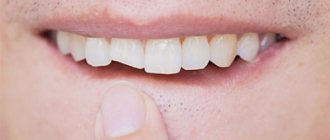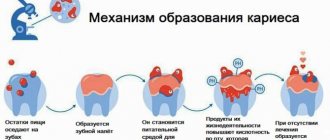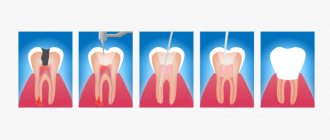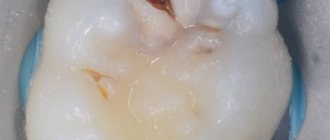05.08.2021 4172
Some patients ask whether pain may appear after cleaning the canal. The concerns are understandable - since the canal has been cleaned, there is no nerve in the tooth. Theoretically, he should not get sick and react to external stimuli. How are things going in practice? Let's look at this issue later in the article.
What is the canal cleaning procedure?
Before moving on to the issue of pain, let’s define what the root canal cleaning procedure itself is. Typically, such surgery is performed because the root is severely damaged. There are two reasons - inflammation or the development of infection.
Most often, root cleaning is performed in patients whom doctors have diagnosed with pulpitis or periodontitis. Cleaning and filling in such a situation are necessary in order to stop the destruction processes and save the tooth. The only alternative is deletion.
During the cleaning process, the soft tissues of the oral cavity are also affected. And here it is important to understand one of the central features of the procedure. Cleaning is done on already inflamed tissues. Since the inflammatory process usually affects large areas and spreads quickly, it will continue to occur for some time. Then the state will fade and stabilize. This usually takes several days.
Due to residual inflammation, the tooth may actually hurt for some time - this is normal. At the same time, the pain itself has a dull, aching character. It is not strong and most patients do not even have to take analgesics. Usually the discomfort intensifies slightly as the evening approaches.
If the patient’s body is in normal condition and nothing affects its regenerative abilities, after two or three unpleasant sensations begin to subside. The feeling of discomfort lasts longer, especially if the operation was traumatic or you have a complex root structure.
You will have to put up with pain much longer if, for some reason, you put off visiting the dentist until the last minute. In this case, the inflammation will become more and more severe, covering large spaces. Also, the rehabilitation process is extended if the patient has any systemic diseases of the body.
What materials are used to fill canals?
The main requirements for such filling materials are dense, hermetically sealed filling of the canals, chemical inertness (the material should not dissolve under the influence of body fluids), radiopacity (it should be clearly visible in the picture). Today, the following types of materials are used for filling dental canals:
- Solid fillers (fillers).
These include gutta-percha (a latex processing product), silver and titanium pins. Silver pins have recently been rarely used, since despite their good antibacterial properties they have a significant drawback - they do not provide complete tightness. - Polymer and natural pastes (sealers)
. A more preferable option is polymer sealers, which adhere better to the walls, do not stain dental tissue and do not dissolve when interacting with tissue fluids. - Glass ionomer cements.
Good adhesion and radiopacity, high biocompatibility and minimal shrinkage are the main positive qualities of such materials. They also have significant drawbacks: low strength, which is why such fillings are short-lived and not designed for serious functional loads. - Calcium hydroxide cements
. Non-toxic, biocompatible, radiopaque materials that exhibit minimal shrinkage, are easily removed if necessary and have bactericidal properties. However, they are considered not too strong and can break under heavy loads on the dental crown. - Polydimethylsiloxanes
. Modern reliable sealants with good therapeutic and operational parameters. Perhaps their only drawback is that this is a new product on the dental market and experience in using such materials has not yet been accumulated. There is no reliable information yet about the experience of patients after such treatment.
In case of inflammation of the tooth canals, the dentist selects the treatment individually, taking into account the type of dental unit, the number and shape of the roots, the patency of the root canals and the further plan for restoring the crown. Taking these factors into account, the filling material is also selected. Many specialists combine materials to achieve optimal characteristics and tightness of closing cavities. Filling techniques
Just 10-20 years ago, the main method of filling dental root canals was to fill them with one type of cement. This is a very simple and not labor-intensive method, but for the patient it has a lot of disadvantages: the channels are filled poorly and unevenly, voids appear in which microbial infection can develop. In addition, such cements quickly shrink and the canals soon have to be re-treated.
Modern dentistry offers completely different filling methods:
- Depophoresis
is the hardware introduction of medicinal and filling materials into the root canal. The technique allows you to effectively fill even curved and hard-to-reach canals. - Obturation with thermophiles
(plastic carriers coated with gutta-percha). A fast, fairly simple and reliable method, which still has the disadvantage of the possibility of material being removed beyond the root tip. - Filling with gutta-percha pin
. - Lateral condensation
is a dense filling of the canals with gutta-percha pins coated with a hardening sealer. A fairly reliable method, however, when using it there is a high risk of tooth root fracture. - Thermomechanical
(sometimes also called rotating condenser sealing) condensation. Recently, it has been used very rarely due to the high risk of complications. - Vertical condensation of heated gutta-percha
. A rather complex and lengthy, but at the same time reliable and durable filling method. - Injection filling with hot gutta-percha
. - Injection of heated gutta-percha
using the continuous wave method. One of the options for vertical condensation, characterized by greater simplicity and at the same time sufficient reliability and tightness of filling the channel. - Thermoplastic injection
of hot gutta-percha. A simple and fast method, which, however, does not always make it possible to densely fill the lateral tubules. - E&Q Plus
is a mixed technique using an injection gun to inject gutta-percha into the canal.
If you have a problem similar to that described in this article, be sure to contact our specialists. Don't diagnose yourself!
Why you should call us now:
- We will answer all your questions in 3 minutes
- Free consultation
- The average work experience of doctors is 12 years
- Convenient location of clinics
Single contact phone number: +7
Make an appointment
What to do if your tooth hurts after root canal cleaning
So when should you start worrying if your tooth hurts after root canal cleaning? The first reason to sound the alarm will be prolonged and severe pain. This gives reason to think that for some reason complications began to develop.
There are several key warning signs that should make you see a doctor:
- The pain does not go away for a long time.
- Instead of calming down, there is a constant increase in pain.
- Instead of a dull and aching pain, the pain becomes sharp, and a sensation of pulsation appears in the tooth.
- The gums become very swollen, and significant tissue swelling occurs.
- The temperature rises and the patient's general condition becomes worse.
In this case, timely consultation with a doctor becomes the key to maintaining your health. This also allows you to prevent the removal of a tooth for which the dentist cleaned the canals.
Symptoms of needing root canals
If you experience prolonged pain from cold or hot water, lasting several minutes, you should suspect inflammation of the nerve in the tooth. The pain can increase gradually, occur after a filling is placed, or with severe tooth decay due to a cold, decreased immunity, stress, or hypothermia. If pain occurs when food hits a certain tooth, when you press on it or tap it with a spoon, then you can assume inflammation of the apical tissues around the root - periodontitis. Cleaning the canals, treating them with medication and filling them is necessary to prevent the spread of inflammation to neighboring areas. In severe cases, complications such as periostitis, osteomyelitis, abscess or phlegmon develop, the latter is treated in a hospital. If the nerve or gangrenous tissue from a tooth is not removed in time, the risk of losing the tooth itself increases over time.
Reasons for the development of complications
The very cause of severe pain in the case of each patient must be considered separately. Among the most common sources of such pathology may be the following:
- Incorrectly chosen treatment method, gross mistakes made.
- The channel was not cleaned correctly.
- The doctor left foreign objects inside the canal, did not clean out the tooth fragment, and broke the instrument.
- The patient had a sudden allergic reaction to anesthesia or root canal filling agents, or various medications taken during treatment.
- The filling was placed poorly.
- Severe periodontitis developed and gum damage began.
- The canal walls were perforated during the cleaning process.
- The root of the tooth has received any damage.
Against the background of all of the above, the inflammatory process can actively develop. It becomes the cause of severe pain experienced by the patient.
Mild but prolonged pain after treatment is normal
Wrong. It is not normal to experience constant pain for up to several months after root canal treatment. Causes of pain include hidden canals that were not cleaned during the procedure, or a crack in the tooth.
In these rare cases where pain persists, patients should be referred to an endodontist who specializes in root canal treatment for a diagnosis and appropriate treatment. In cases where the root or tooth is destroyed and no treatment method is suitable, the dentist has no choice but to remove the tooth.
What to do if your tooth hurts after root canal cleaning
There can be many answers to the question of why a tooth hurts after root canal cleaning. For this reason, it is very important to pay attention to the characteristics of the individual patient’s body.
If you notice the first signs of the inflammatory process described in this material, you should consult a doctor as soon as possible.
The dentist carries out several basic actions:
- Collecting an anamnesis, taking into account the characteristics of the patient’s condition, the nature of the pain, medications taken, and personal characteristics of the body.
- X-ray of the affected tooth, examination of the condition of the gums, canals, assessment of the quality of the work performed.
- Opening the seal, re-cleaning, using disinfectants.
- Prescribing the patient a course of anti-inflammatory drugs and other medications.
Timely actions help to significantly reduce potential harm to the human body and ensure that the tooth can be saved.
Toothache disappears immediately after the procedure
Wrong. After completing the treatment procedure, the patient will feel a significant improvement. However, it is normal for the tooth to remain sensitive for a few days after the procedure - in this case, taking painkillers may help. Minor pain may be present, especially when chewing, and may persist for several weeks. After this period, the pain should completely disappear.
Is it possible not to experience any pain after root canal treatment? Yes, this is possible, and it depends on how difficult the treatment process was and whether the tooth was infected before the dental intervention.
How to prevent pain and complications
Regardless of the field of medicine, doctors agree with a simple statement - it is much easier to prevent complications from developing at all than to treat them. There are a few simple recommendations that you should follow:
- Pay close attention to who is performing the operation on you. In our clinic, the task is performed by experienced surgeons who are well aware of all the features of the process. This ensures that mistakes are eliminated - the canal is filled correctly, and there are no fragments or dental instruments left inside.
- If you have previously had an allergy to any analgesics or anti-inflammatory drugs, tell your doctor.
- Don't put off visiting your doctor. The longer you leave a tooth untreated, the greater the risk of numerous potential complications.
- Ask how long the tooth hurts after root canal cleaning in your specific case. The doctor can make a prognosis based on information about the health status of a particular patient.
Also remember that if after cleaning the canals you have any signs of inflammation, you need to see a doctor as soon as possible. It is strictly forbidden to use self-medication, drugs without recommendation, or folk remedies. All this can only make the situation worse.
Need to take painkillers
Right. Relatively, this is true. The pain experienced after root canal treatment is usually caused by inflammation around the tooth and may only last for a limited period of time. This process can be successfully managed with the help of common anti-inflammatory drugs: ibuprofen (Advil, Motrin), acetaminophen (Tylenol).
If severe pain continues for several months after the procedures, you should consult a dentist or endodontist to avoid possible complications.
Contact us for the right treatment
Our clinic employs dentists with extensive experience. They perform high-quality cleaning of dental canals and carefully ensure that the person does not experience any complications. We will also give all the necessary advice regarding the course of the recovery process, and recommend the necessary means to reduce pain and relieve inflammation.
We offer our customers competitive prices and special discounts. To get your first appointment and get professional advice, call the numbers listed on the website or leave a request.
Root canal treatment is expensive
Right. Although root canal treatment is expensive, it allows you to preserve the tooth, as well as its functionality and chewing functions. If you have a root canal and install a crown on the tooth, the cost of treatment will be less than if you remove the tooth and replace it with a bridge or dental implant.
The cost of treatment will depend on how many root canals the tooth has, whether it is the first time it has been treated, and on the qualifications of the dentist (general dentist or specialist).
After sinus lift
Speaking about the reasons for the increase in temperature after dental therapy, it is necessary to mention bone grafting. Such an operation sometimes precedes procedures to restore the integrity of the row. The need for it arises if the patient has been walking for a long time with a toothless smile. Then the gums in the areas of damaged teeth begin to “sag.”
This effect is due to atrophy of bone tissue and is due to the fact that certain areas of the jaw do not take part in the process of chewing food. Then, before installing the implant, the doctor performs bone grafting. During this procedure, the gum level is raised by placing a special collagen membrane under the soft tissue. After this, they wait about three to four months until the introduced artificial material takes root. Only after this they proceed to implantation.
The human body does not always react calmly to an established bone sample. In the first days after plastic surgery, ailments often appear. There's nothing wrong with that. The main thing is that the patient takes the medications prescribed by the doctor.
Summarize. If you experience a high fever after dental treatment, do not worry. This is usually a normal reaction to complex interventions. But be careful. The fever should not persist for a long time. You shouldn't guess what's going on in your mouth. If you have the slightest doubt, visit your doctor again. He will tell you how to normalize the situation.
Root canal treatment is a lengthy process that requires several visits to the doctor.
Wrong. Today, root canal treatment can take one to two hours if there are no complications. The number of visits to the dentist often depends on the condition of the tooth and the number of canals in it.
In cases where the damage is severe, your dentist or endodontist may place medication inside the canal to prepare (disinfect) the inside of the tooth and then finish treatment after a few days. But if there are no lesions or complications, all procedures can be performed in one visit.
Content:
- After caries closure
- After root canal treatment
- After extraction
- After implantation
- After sinus lift
The problems that dentists have to solve can be serious or not so serious.
But any medical intervention must be carried out in accordance with established norms and rules. Only then will the likelihood of complications develop to a minimum. One of the most common unpleasant symptoms after dental treatment is fever. Many patients are confused and do not know what to do when it increases. After all, it is not always clear whether a fever is related to a recent dental course.
Dentists insist that if the temperature rises after dental treatment, patients immediately consult a doctor. Timely receipt of qualified medical care is the most reasonable decision in such situations.
After caries closure
Sooner or later, everyone faces the need to close carious cavities. With caries, the pathological process does not extend beyond the hard tissues. If your health condition worsens after filling, you can assume:
- development of a viral, infectious or bacterial infection not related to a recent medical intervention;
- the addition of complications such as pulpitis, abscess, phlegmon.
Determining the root cause of the problem is actually not difficult. If the sealed molar looks healthy and does not hurt, the gums are not swollen or swollen, and the mucous membranes are not ulcerated, it means that with a 90-95% probability the temperature has not increased due to treatment at the dental center. It’s just that at the time of therapy the patient was already sick, but the symptoms of the disease had not yet manifested themselves or were barely noticeable.
The stress experienced during the operation of the drilling machine can create conditions for the rapid spread of infection. Then, upon coming home, a person will see frightening numbers on the thermometer.
After extraction
Extracting the root unit is a surgical procedure. It is associated with a violation of the integrity of oral tissues. It is not surprising that the human body reacts so sharply to the treatment.
Normally, after removal, the thermometer can show up to 38.5°C for no longer than three days. It is not advisable to take antipyretics - such tactics can change the course of recovery reactions. However, in some cases, doctors prescribe anti-inflammatory drugs to speed up regeneration processes. Some of them not only stop inflammation, but also normalize body temperature. If the doctor told you to use pills, you should do so. Any amateur activity is prohibited here.
In difficult clinical situations, antibiotics are prescribed after extraction. There are patients who are critical of such prescriptions. It seems to them that antibacterial drugs lower the immune system and their use after an ordinary removal of a unit is unjustified.
This attitude towards antibiotics is wrong. They help damaged tissues heal faster and eliminate the development of postoperative complications. Dentists never prescribe them just like that. Therefore, if a specialist issues a prescription after extraction, you need to take its prescription seriously.
Most often, an elevated temperature is recorded after removal:
- "eight";
- incisors, fangs, molars, if the operation was preceded by an advanced purulent process;
- several units at once.










